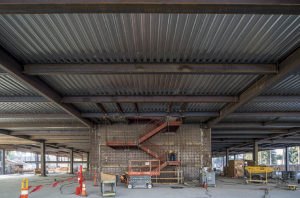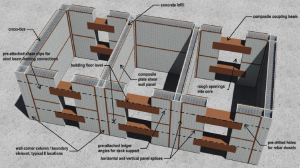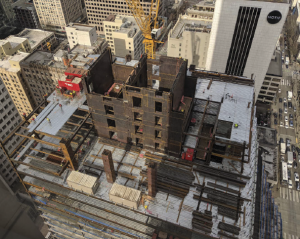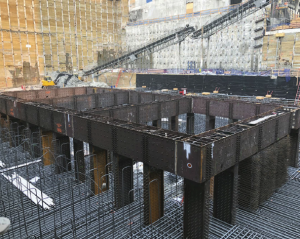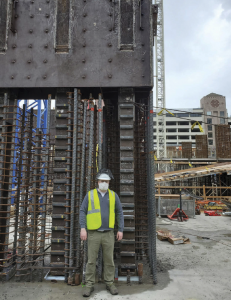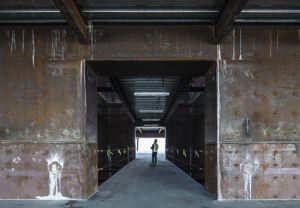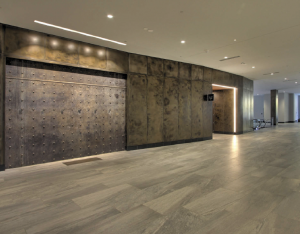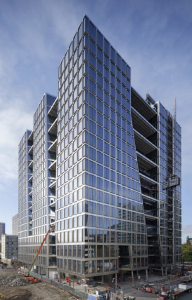200 Park Avenue – SpeedCore 2.0 from Three Perspectives
Source: STRUCTURE magazine
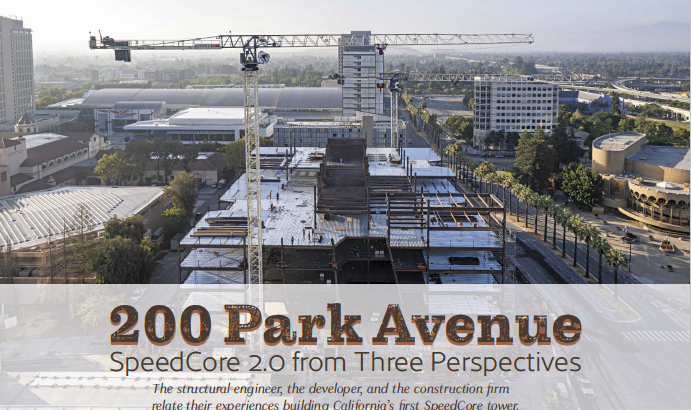
By Ron Klemencic, P.E., S.E., Hon. AIA, Casey Kraning, Casey Wend, Kevin Englund, Chris Grimmer, and Mike Mills
Seattle’s Rainier Square introduced the world to SpeedCore. San Jose’s 200 Park Avenue expands SpeedCore’s possibilities. For decades, a reinforced concrete core surrounded by structural for high-rise buildings. And why not? It is a cost-effective and efficient way to brace against wind and seismic loads while meet-ing the needs of architects and leasing agents who seek to off er unencumbered office and residential space. But unfortunately, a concrete core’s lengthy construction cycle can lead to delays before steel erection can begin. In 2005, Purdue University researchers started to explore a new structural system that would satisfy architectural and leasing demands, provide adequate strength and stiff ness, eliminate steel erection delays, and reduce the overall construction schedule. Th e solution? Concrete-Filled, Composite-Plate Shear Wall (CF-CPSW) panels. These prefabricated, modular panels – two steel plates spaced apart by interconnect-ing tie rods – could be stacked atop one another like giant LEGO® blocks to form a traditional structural core. Once erected, the panels could be filled with concrete to create a stiff and strong composite structural core – like an ice cream sandwich, with the panels serving as the cookies and the concrete serving as the ice cream filling. Initial research results demonstrated exceptional performance and the ability to achieve ambitious improvements in construction speed.
Steel Framing and SpeedCore at 200 Park Ave. | Photo: Jason O’Rear
SpeedCore Basics | Image: MKA
After nearly 10 years of laboratory testing, this new structural system, appropriately dubbed SpeedCore by the American Institute of Steel Construction (AISC), was ready to be incorporated for the first time into a commercial high-rise building – Seattle’s 58-story, 850-foot-tall Rainier Square. Rigorous design and review processes preceded the project’s 2017 groundbreaking. As a result, instead of completing Rainier Square in 32 months using a traditional reinforced concrete core, the team used SpeedCore to complete the project in just 22 months – an astonishing 10 months faster than planned!
The Structural Engineer’s Perspective
Rainier Square’s success encouraged Jay Paul Company, the developer of 200 Park in San Jose, California, to incorporate SpeedCore into its project’s design and construction. This 19-story, 1.3-million-square-foot commercial office building includes three parking levels above grade and four below grade extending 46 feet where the tower rests on a mat foundation. Two structural cores centrally located on the floor plates and surrounded by structural steel framing brace the tower. The design and approval processes began in 2019. The project team chose a reinforced concrete, beam-and-slab system for below-grade construction; this facilitated an early construction start and allowed ample time to plan, procure, and fabricate the SpeedCore panels.
Rainier Square offered numerous les-sons and inspired additional research to improve SpeedCore’s efficiency, effectiveness, and constructability. Under the leadership of Dr. Amit Varma at Purdue University and Dr. Michel Bruneau at the University at Buffalo, researchers made advancements to overall panel stability, cross-tie spacing, link beam detailing, foundation connections, and fire protection. These new research results, as well as the lessons learned during Rainier Square’s construction, were incorporated into 200 Park and benefitted the structural design in many ways:
Expanded Cross-Tie Spacing. Rainier Square utilized 240,000 one-inch-diameter cross-ties spaced at 12 inches on-center (o.c.) over the entire extent of the SpeedCore wall panels. The cross-ties are a critical part of each wall panel as they perform multiple functions, including:
- Temporary stability of the prefabricated panels for handling and shipping
- Buckling stability for the wall panels during the erection of the surrounding steel
- Resistance to hydro-static pressures during concreting
- The mechanical connection between the steel plates and the hardened concrete enforces composite action
- Confining pressure for the concrete subject to compressive stresses
Purdue University research showed wider cross-tie spacings were possible where lower demands are expected. For 200 Park, the design specified cross-ties spaced 18 inches on-center (o.c.) above Level 6, resulting in more than a 50% reduction in cross-tie density for approximately three-quarters of the wall height.
No Cross-Ties in Link Beams. Rainier Square included horizontal and vertical cross-ties over the entire length of all link beams crossing over wall openings throughout the tower. However, Purdue University research indicated these cross-ties were unnecessary; instead, headed studs were used to prevent local plate buckling. The design of 200 Park took full advantage of this design improvement and eliminated cross-ties in all of the link beams.
SpeedCore Erection at Rainier Square, Seattle | Photo: MKA
SpeedCore Foundation Connection at Rainier Square | Photo: MKA
Transition from Concrete to Steel. SpeedCore for Rainier Square started immediately above the tower’s mat foundation, making the connection from the steel wall panels to the concrete foundation straightforward using a series of steel stanchions embedded into the mat. The 200 Park project included a below-grade, cast-in-place concrete parking structure that influenced the location of the concrete-to-steel transition to a floor level well above the tower’s mat foundation. A stanchion approach similar to Rainier Square was used, but 200 Park’s stanchions were embedded into the tight confines of a ductile concrete shear wall. Extraordinary coordination between the reinforcing steel detailer and placers ensured this transition was buildable while achieving strict confinement requirements for the cast-in-place concrete shear walls.
200 Park Ave. SpeedCore connection to Special Reinforced Concrete Shear Walls
200 Park Ave. SpeedCore Lobby Openings | Photo: Jason O’Rear
Elimination of Spray-on Fireproofing. Rainier Square adopted spray-on fire protection for the SpeedCore wall panels. However, subsequent research at Purdue indicated that spray-on fireproofing could be eliminated if the SpeedCore wall panels met certain parameters regarding overall wall thickness, wall-plate thickness, and cross-tie spacing. The design team presented these research results to the City of San Jose’s Planning, Building & Code Enforcement officials, who favorably considered the proposal to eliminate spray-on fire protection of SpeedCore wall panels as long as beam/wall connections and deck support angles remained protected.
Procurement. Procurement of the wall-plate material was a source of great discussion for both Rainier Square and 200 Park. American mills roll plate material to a maximum width of 10 feet. Only South Korean and German mills roll wider plates. For Rainier Square, the plate material was purchased from South Korea, where plates could be produced to match the typical story height of 14 feet. For 200 Park, domestic plates were selected at a width of 10 feet, necessitating shop splicing of plates to prefabricate individual full-story-tall wall panels. In the future, Nucor plans to produce wider plate material in a newly constructed domestic mill.
MEP Coordination. Penetrations through the SpeedCore panels for ductwork, piping, and electrical conduits required careful planning and coordination to facilitate prefabrication. For both projects, detailed coordination efforts during the design phases, including weekly meetings with the various subcontractors, were essential to incorporating the necessary openings into the design, shop drawings, and fabrication process.
Fabrication. The time required to fabricate a single wall panel exceeds the time to erect the same wall panel, necessitating advance fabrication and stockpiling of wall panels for just-in-time delivery on site. Careful planning of the overall workflow in the fabrication shop, all the way to the final delivery point, was required to meet the aggressive erection schedule of both projects.
Shipping. Planning the shipping routes and understanding the state-by-state trucking requirements were essential for the smooth and timely delivery of SpeedCore wall panels to the site. Rainier Square wall panels were fabricated in Portland, Oregon, requiring shipping on both Oregon and Washington highways. For 200 Park, wall panels were fabricated in Phoenix, AZ, and Stockton, CA, requiring shipping on Arizona, Nevada, and California highways. In both instances, shipments were deemed wide loads, demanding that trucking companies follow each state’s specific laws. Upon arrival at the site, deliveries in downtown Seattle were limited to the early morning hours before downtown office workers arrived. Deliveries in downtown San Jose proved to be more flexible.
Erection. Rainier Square and 200 Park completed full-scale mock-ups of a portion of the core walls, allowing the contractors to learn how best to handle, erect, connect, and concrete the wall panels. While costly, these mock-ups proved invaluable to the construction teams, allowing the on-site construction work to proceed with a limited learning curve.
One notable item for both projects was the relationship between the fully concreted SpeedCore panels and the tie-ins for the tower cranes. In the case of Rainier Square, the tie-ins and related tower crane jumps were conditioned by the location of the fully concreted SpeedCore wall panels. Construction of 200 Park took a more aggressive approach, using the strength and stability of the “un-concreted” SpeedCore panels to support crane tie-in loads. This approach required rigorous engineering assessments to confirm its application and limits.
The SpeedCore wall panels for Rainier Square and 200 Park exhibited a small amount of warpage in the wall-plate material caused by heat associated with completing the cross-tie con-nections. In most instances, this modest warpage could easily be managed with the field-welded panel-to-panel wall splice. However, in only one instance was the warpage significant enough that a modified field splice detail was required.
SpeedCore left exposed as lobby “art” at Rainier Square | Photo: MKA
The Developer’s Perspective – Opting for SpeedCore
Implementing a new technology or construction methodology is not without risks, nor is it something to take lightly. As the design concepts progressed for the 200 Park project, the teams at Gensler and MKA brought the SpeedCore system to Jay Paul Company’s attention and suggested that it may be a good fit for the project. As a best-in-class producer of class A office space, the selected process needed to maintain the company’s image and meet four key objectives: Marketable (Leaseable), Permittable, Cost Appropriate, and Schedule Appropriate.
MKA’s confidence in SpeedCore went a long way in Jay Paul Company’s decision to choose SpeedCore for this project. Ron Klemencic and his team at MKA have a unique ability to concisely convey extremely complex engineering elements into a digestible format needed to make ownership’s key decisions. As the first structural concepts for the 200 Park project were being priced and considered, the development team visited Rainier Square to hear firsthand the benefits and challenges of this novel structural system. Ultimately, they came away confident that SpeedCore was a viable option for 200 Park.
MKA took a very active role in early discussions with the City of San Jose, bolstering confidence that City officials would be supportive and have the processes in place to consider, review, and ultimately permit this construction method within the aggressive construction and procurement schedule. The City review, concur-rent peer review, and permitting were not without challenges, but all parties came away with lessons learned and, ultimately, a better product.
Level 10 Construction took the lead in analyzing key questions around schedule and cost. Along with partners at Scuff Steel and input from the Special Inspector (Construction Testing Services), Level 10 compared the more traditional concrete core and BRB/Sheet Plate Shear Wall systems and discovered that schedule and cost gains could be achieved. As a result, the implementation team was confident that it could achieve the desired results.
The 200 Park project and its SpeedCore component have received a lot of press and accolades from the broader building community. However, this did not drive the owner’s decision to build using SpeedCore. Instead, the team was focused on bringing an iconic building to downtown San Jose that meets the needs of our desired tenants. SpeedCore fit well with broader project goals, and confidence in Gensler, MKA, the City of San Jose, Level 10, and the rest of the implementation team made this a rational decision rather than a risky decision.
As 200 Park nears completion and becomes a defining landmark in downtown San Jose, there is pride amongst the project’s team and confidence in its decision to use SpeedCore.
The Contractor’s Perspective – Embracing New Ideas
When Jay Paul Company approached Level 10 Construction about building 200 Park, only the second SpeedCore project in the world, three factors required consideration: confidence in the ability to execute the work, an understanding of the risks, and assurance that the project made financial sense.
Level 10’s VPs of Operations, Casey Wend and Kevin Englund, met with Ron Klemencic to get an overview of the design and key project fundamentals. After multiple meetings, the team toured the first-ever SpeedCore project, Rainier Square, in downtown Seattle to see SpeedCore firsthand and meet the project’s erector, The Erection Company of Lake Stevens, Washington.
Confident in understanding the dynamics of a SpeedCore project, schedule and cost studies were performed to determine if SpeedCore made sense for Jay Paul Company and 200 Park. The study showed SpeedCore could reduce the project’s structural frame-and-deck schedule by at least three months. In addition, the reduced general conditions and site requirements costs, combined with other trade offs realized from building a CF-CPSW core instead of a traditional reinforced concrete core, ultimately netted a reduction in estimated construction costs. Of course, similar studies would need to occur on future projects, given the price fluctuations in steel and other commodities since the pandemic. Still, after the studies were presented to Jay Paul Company, a decision was made to move forward with the world’s second SpeedCore project and the first such project in California.
The next step was to secure the right subcontractor to fabricate and erect the project. After multiple pre- and post-bid interviews with four different structural steel subcontractors, it was recommended that Schuff Steel be awarded the project. In addition to cost, some of the considerations that went into this decision included fabrication plant capacity, detailing resources, labor and equipment resources, location, and history with past Level 10 projects.
Schuff Steel provided a well-prepared presentation that showed they invested significant time in planning how to fabricate and erect this new design technology successfully. This included substantial pre-modeling and logistical planning graphics and videos as part of their proposal and interview.
SpeedCore requires the early coordination of penetrations for mechanical, electrical, plumbing, and fire protection (MEPF). As a result, MEPF design-build subcontractors participated in design and coordination meetings weekly to fix the locations and sizes of SpeedCore penetrations in time for Schuff Steel to provide detailing and obtain MKA’s approvals to allow fabrication in sequence with all the other standard CF-CPSW units.
When building with SpeedCore, slab on metal deck reinforcements must be detailed early because dowels or drag bar reinforcing locations require holes. The steel fabricator needs to incorporate the locations of these holes into the shop drawings. Providing this information in a con trolled shop environment is more cost-effective than drilling holes in the field.
During the coordination process, elements such as the coupling beams which framed the header of the large core walkway open-ing had opening restrictions. These restricted locations needed to be identified early so the alternate locations could be established and coordinated with the interfacing trade work. The penetrations also had to be coordinated with additional internal trusses above MKA’s design that Schuff Steel used as a quality control measure for alignment during the fabrication of the composite plate shear wall modules and to ensure no distortion occurred during trucking and rigging of the units.
The time invested in early coordination and review for the reinforcing steel holes and MEPF openings paid off significantly, avoiding costly rework in the field. No SpeedCore field modifications were needed for MEPF penetrations in the core walls.
Another unique consideration during the planning of the project was the evaluation of MKA’s requirements for the placement of concrete in the CPSW panels relative to the concrete placement of the slabs on metal deck and the number of levels of erected steel ahead of filling the core.
MKA’s documents required the 10,000 pounds per square inch (psi) concrete to be placed in the CPSW panels directly below a level and reach a minimum compressive strength of 4,000 psi before any concrete on the metal deck could be placed on that level. This requirement added a constraint to the project schedule, so Level 10 and Schuff Steel partnered with Simpson Gumpertz & Heger (SGH) to evaluate the actual loading conditions and identify solutions. SGH, acting as Schuff Steel’s erection engi-neer, modeled and calculated that one level of concrete fill on metal deck could be placed above one level of un-grouted CPSW. SGH was also able to design additional internal stiffening of the CPSW, thus providing crews some flexibility in the scheduling and sequencing of the work. These studies and additional measures supported the project’s schedule needs and contributed to its successful execution.
There were many other aspects of unique thinking, planning, and requirements, including a full-size CPSW Steel mock-up, a full-size grout placement mock-up, tower crane sizing, site logistics, fire rating studies, and elevator shaft considerations. Given the success of the design’s implementation on 200 Park, the design technology of SpeedCore should be considered for future projects.
200 Park Ave. Completed | Photo: Jason O’Rear
SpeedCore 3.0?
Rainier Square proved SpeedCore’s potential to the world. It also offered myriad lessons and inspired additional research to improve SpeedCore’s efficiency, effectiveness, and constructability – all of which were incorporated into the design and construction today of 200 Park. But, of course, it is only time before another developer chooses to build with SpeedCore. Whatever that project might be remains to be seen. But one thing is certain now – it is an exciting time to witness this evolution in high-rise construc-tion and structural systems. ■
Ron Klemencic, Chairman and CEO, Magnusson Klemencic Associates. Casey Kraning, Director | Real Estate Development, Jay Paul Company. Casey Wend and Kevin Englund, Partners/VPs Operations, Chris Grimmer, Senior Project Manager, and Mike Mills, Senior Superintendent, Level 10 Construction.
Link to Original Article (may require registration)
https://www.structuremag.org/?page_id=22545 

